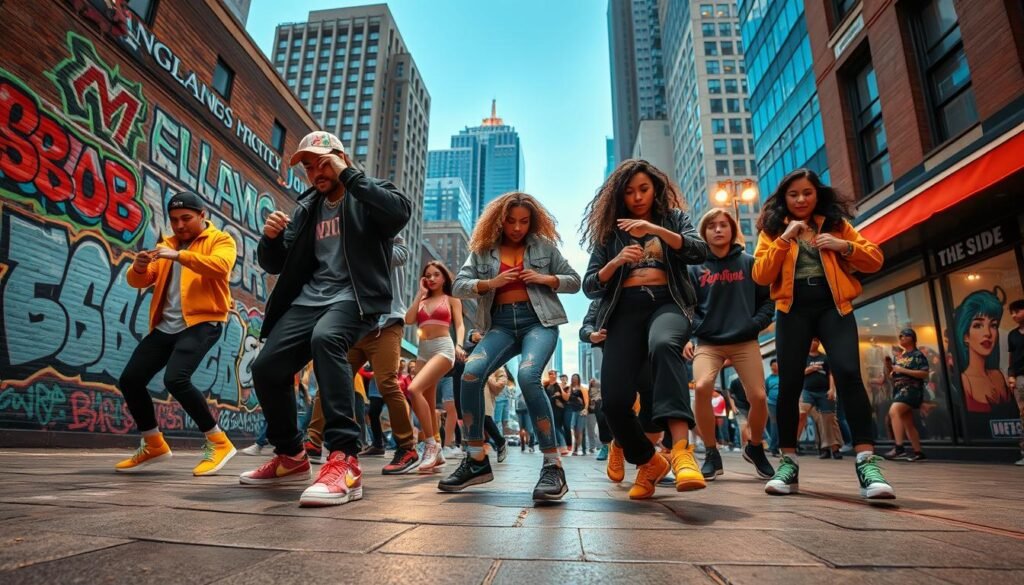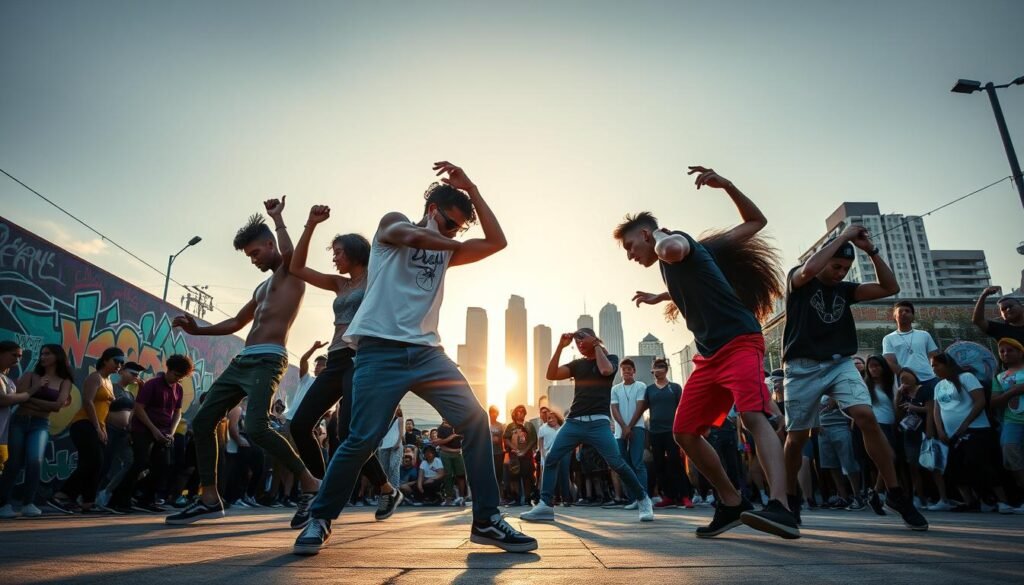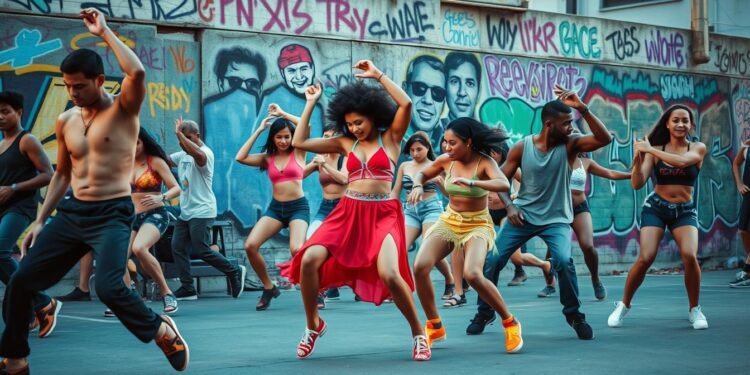Did you know that the very foundations of contemporary urban dance culture can be traced back to the 1970s in the streets of the Bronx, New York City? This cultural revolution, born out of the socio-economic challenges faced by African American and Latino communities, would go on to shape the world of dance, fashion, and music for generations to come.
Hip-hop emerged as a creative and expressive response to these challenges, with the neighborhoods of the South Bronx serving as the breeding ground for innovation. The fusion of various elements, including DJing, MCing (rapping), graffiti art, and dance, gave rise to a cultural movement that would forever alter the landscape of popular culture.
The streets became the backdrop for this cultural revolution, as young people discovered new ways to express themselves, repurpose everyday items, and showcase their individual creativity. This ethos of self-expression and personalization would go on to influence not only the dance styles that emerged, but also the fashion and aesthetics that became synonymous with the hip-hop movement.
Key Takeaways
- Hip-hop emerged in the 1970s in the South Bronx, New York City, as a creative response to socio-economic challenges.
- The fusion of DJing, MCing, graffiti art, and dance gave rise to a cultural revolution that would shape popular culture.
- The streets became the backdrop for this movement, with young people expressing themselves through dance, fashion, and art.
- The ethos of self-expression and personalization influenced the development of iconic dance styles and fashion aesthetics.
- The origins of street dance can be traced to this cultural revolution in the Bronx, which would have far-reaching impacts.
The Birth of Hip-Hop
The captivating history of hip-hop dance can be traced back to the 1970s, when this dynamic cultural movement emerged in the South Bronx, New York City. Amidst the socio-economic challenges faced by African American and Latino communities, hip-hop arose as a creative and expressive response, fusing together various elements that would shape the dance revolution.
Hip-hop’s Emergence in the South Bronx
The neighborhoods of the South Bronx became the breeding ground for this cultural innovation, with the streets serving as the backdrop for the birth of hip-hop. It was in this vibrant community that the fusion of DJing, MCing (rapping), graffiti art, and dance coalesced, giving rise to a powerful and influential movement that would captivate the world.
The Fusion of DJing, MCing, Graffiti, and Dance
At the heart of this cultural revolution was the interplay between these distinct yet interconnected elements. DJs, like the legendary DJ Kool Herc, introduced the massive sound systems from Jamaica to the inner-city parties, setting the stage for the rhythmic and percussive foundations of hip-hop. Pioneers such as Grandmaster Flash, Afrika Bambaataa, and Grand Wizard Theodore further developed the art of isolating and extending the break beat, stimulating the improvisational dance that would become synonymous with the hip-hop culture.
As the dance revolution gained momentum, graffiti artists and MCs (rappers) joined the fray, adding their unique expressions and narratives to the evolving art form. The South Bronx became a hub of creativity, where these diverse elements converged to form the quintessential hip-hop culture that would captivate the world and inspire generations to come.
Street Style and Self-Expression
Street dance has long been a powerful medium of self-expression, rooted in the rich cultural heritage of urban communities. In the face of limited resources, early pioneers of hip-hop culture repurposed and personalized their clothing, creating unique looks that set them apart from mainstream fashion. This practice of ‘street style’ became a defining hallmark of the hip-hop movement, reflecting the individuality and creativity that were central to its rise.
Repurposing and Personalizing Clothing
Resourceful hip-hop enthusiasts often turned to thrift stores, secondhand shops, and their own ingenuity to construct their signature styles. They would take ordinary garments and transform them through customization, adding patches, pins, or intricate designs to create one-of-a-kind ensembles. This DIY approach allowed them to express their personal flair and stand out in a sea of conformity.
Individuality and Creativity in Fashion
The street style of early hip-hop pioneers was a celebration of individuality and self-expression. Rather than adhering to mainstream fashion trends, they embraced their unique tastes and preferences, often drawing inspiration from their cultural roots and personal experiences. This artistic approach to fashion became a form of self-empowerment, enabling them to assert their identity and carve out a space within the urban landscape.
Today, the legacy of street style and self-expression continues to shape the world of fashion, as the influence of hip-hop culture permeates the industry. From haute couture runways to streetwear collectives, the spirit of innovation and personal flair that defined the early days of hip-hop remains a driving force, inspiring a new generation of style-conscious individuals to embrace their authenticity and creativity.
| Key Statistics on Street Dance | Value |
|---|---|
| Street dance as a global phenomenon | Captivating audiences worldwide, showcasing the power of self-expression and community building |
| Origins of street dance | Traced back to the African diaspora in the United States, with the Lindy Hop being one of the earliest forms |
| Emergence of hip-hop dance | In the 1970s, introducing styles like breaking, popping, and locking as key elements |
| Global influence of street dance | Transcending borders, influencing communities worldwide, such as capoeira in Brazil |
| Diverse styles of street dance | Encompassing tap dance, contemporary styles like krumping and waacking, reflecting its global evolution |
| Impact on youth empowerment | Evident through success stories like the “Street Kings” dance crew, demonstrating the transformative power |
| Breakdancing’s revolutionary impact | Introducing acrobatic moves and intricate footwork, challenging traditional dance norms |
“Street dance has become a global phenomenon that continues to captivate audiences, showcasing the power of self-expression and community building.”
Influence of African and African American Aesthetics
The vibrant and dynamic urban dance culture that has become synonymous with the dance revolution movement is deeply rooted in the rich aesthetics of African and African American heritage. Hip-hop fashion, a cornerstone of this cultural landscape, draws profound inspiration from the bold colors, captivating patterns, and expressive prints that have long been hallmarks of traditional African garments.
As early hip-hop artists sought to celebrate and honor their ancestral roots, they infused their sartorial choices with elements that evoked the vibrancy and pride of their cultural legacy. The result was a fusion of contemporary style and timeless African influences, creating a distinctive visual language that has since echoed across the global stage.
- The Cuban hip hop festival in 1999 drew a crowd of thousands, showcasing the widespread appeal of this cultural movement.
- Hip hop culture includes rapping, d-jaying, beat-making, and a dance form known as b-boying, all of which have their origins in African and African American artistic traditions.
- In the ’80s, Cuban rapper Alexey found inspiration from hip hop music broadcasted by 99 Jams FM from Miami, demonstrating the transnational nature of this cultural exchange.
As the urban dance culture and dance revolution movement continue to evolve, the enduring influence of African and African American aesthetics remains a defining characteristic, ensuring that the rich tapestry of this cultural heritage is woven into the very fabric of the contemporary creative landscape.
“African American creative arts of dance, music, literature, theater, and visual art have evolved over time from the slavery period through the Harlem Renaissance.”
Rise of Sneaker Culture
Sneakers have become synonymous with street style dancing and hip-hop fashion. From iconic brands like Adidas to Nike, Puma to Converse, sneakers have transcended their athletic origins to become powerful symbols of identity and status within the dance as social expression movement.
The love for sneakers grew hand in hand with the rise of breaking and popping origins and the need for functional footwear that could withstand the demands of dynamic dance battles and energetic moves. As hip-hop culture gained mainstream popularity, sneakers became a crucial component of the distinct visual aesthetic that defined the era.
Sneakers as Symbols of Identity and Status
Brands like FUBU, Karl Kani, and Sean John became synonymous with the hip-hop fashion movement, cementing the role of sneakers as a means of self-expression and social belonging. Iconic sneaker collaborations, such as Run DMC’s endorsement of Adidas Superstars, further solidified the sneaker’s status as a cultural touchstone.
Functional Footwear for Breakdancing
The emergence of breakdancing during the 1970s in the South Bronx, New York City, drove the demand for sneakers that could withstand the rigors of dynamic dance moves. Brands like Converse and Keds, which had initially catered to athletes, found new relevance as the preferred footwear for the growing breakdancing community.
The release of game-changing sneakers like the Air Jordan line in the mid-80s not only showcased technological advancements but also emphasized the impact of celebrity endorsements on sneaker culture. This paved the way for a new era of sneaker-driven fashion, where performance and style converged to create an enduring legacy.

Branding and Logomania
Hip-hop culture has long been intertwined with the world of fashion, and nowhere is this more evident than in the realm of branding and logomania. As the urban dance revolution swept across the globe, artists and fans alike embraced fashion as a means of self-expression, transforming clothing into a canvas for bold statements and personal identities.
Clothing as Self-Promotion
The rise of hip-hop’s popularity saw artists and enthusiasts adorning themselves with recognizable logos, turning fashion into a form of self-promotion. Brands like FUBU, Karl Kani, and Sean John became synonymous with the hip-hop fashion movement, representing not just style but also the entrepreneurial spirit that had blossomed within the community.
Iconic Hip-Hop Fashion Brands
- FUBU: Founded by Daymond John, this streetwear brand grew into a $350 million empire, seamlessly blending hip-hop aesthetics with urban streetwear.
- Karl Kani: A pioneer in the urban fashion industry, Karl Kani’s designs captured the essence of the hip-hop lifestyle, featuring bold logos and a distinctive urban flair.
- Sean John: Launched by music mogul Sean “Diddy” Combs, this brand became a symbol of hip-hop’s commercial success, elevating the genre’s fashion influence to new heights.
The enduring influence of hip-hop on the fashion industry cannot be overstated. From the iconic Gap commercial featuring LL Cool J and FUBU, to the transformative work of designers like Virgil Abloh, the urban dance culture’s impact on branding and logomania has left an indelible mark on the world of style.
“Hip-hop fashion has become a global phenomenon, transcending cultural boundaries and redefining the way we think about style.”
Origins of Street Dance: A Cultural Revolution
Hip-hop’s origin lies in the vibrant streets of the South Bronx, where a fusion of artistic expression gave birth to a cultural revolution. The fashion choices of early hip-hop pioneers became intertwined with the essence of the genre, fostering a unique street style that celebrated self-expression, cultural heritage, and individuality.
The 1920s marked the emergence of the Charleston as a significant dance, symbolizing the spirit of liberation and rebellion during the Jazz Age. The swing era of the 1930s and 1940s introduced dances like Lindy Hop and Jitterbug, reflecting the camaraderie and escape sought during times of hardship. The 1950s witnessed the popularity of dances like the Twist and Jive, showcasing the influence of rock ‘n’ roll music for inspiring new dance trends.
The 1970s were a pivotal era for the urban dance culture, as the disco era brought about dance styles like the Hustle and the Electric Slide, turning dance floors into arenas of self-expression and celebration. This was followed by the emergence of breakdancing and street dance styles as part of hip-hop culture in the 1980s, highlighting urban culture, social commentary, and artistic expression.
The 1990s rave culture was driven by electronic dance music (EDM) and techno beats, fostering freestyle and euphoric movements reflective of unity and uninhibited self-expression. In the digital age, platforms like TikTok have popularized dance challenges such as the Harlem Shake, the Dab, and the Floss Dance, uniting people worldwide around shared trends.
Today, hip-hop dance has evolved into a respected art form, with its influence extending to contemporary dance, commercial choreography, and even international dance styles. The rich history of urban dance culture and hip-hop dance history continues to inspire and captivate audiences around the globe.
| Era | Significant Dance Styles | Key Characteristics |
|---|---|---|
| 1920s | Charleston | Spirit of liberation and rebellion |
| 1930s-1940s | Lindy Hop, Jitterbug | Camaraderie and escape during hardship |
| 1950s | Twist, Jive | Influence of rock ‘n’ roll music |
| 1970s | Hustle, Electric Slide | Self-expression and celebration |
| 1980s | Breakdancing, Street Styles | Urban culture, social commentary, artistic expression |
| 1990s | Freestyle, Euphoric Movements | Unity and uninhibited self-expression |
| 2000s-Present | Harlem Shake, Dab, Floss Dance | Global dance challenges and trends |
Influence on Mainstream Fashion
Hip-hop’s influence on fashion extends far beyond its grassroots beginnings. As the genre gained mainstream recognition, elements of street style dancing and hip-hop fashion trends started to influence high fashion runways, streetwear brands, and pop culture. Baggy pants, oversized hoodies, bucket hats, and gold chains all found their way into the fashion lexicon, transcending cultural boundaries and becoming iconic symbols of hip-hop style.
Hip-Hop Style on High Fashion Runways
The rise of street style dancing and the dance as social expression in hip-hop culture has had a profound impact on mainstream fashion. Major designers have embraced the bold, unapologetic aesthetic of hip-hop, incorporating it into their high fashion collections. From oversized silhouettes to streetwear-inspired pieces, the influence of hip-hop is undeniable on the runway.
Transcending Cultural Boundaries
The cultural impact of hip-hop fashion trends extends far beyond the genre’s origins. Streetwear and hip-hop style have become global phenomena, with brands and designers around the world drawing inspiration from the distinctive aesthetics. This cross-cultural exchange has helped to break down barriers and celebrate the diversity of fashion as a universal language of self-expression.
| Year | Hip-Hop Fashion Trend | Impact on Mainstream Fashion |
|---|---|---|
| 1970s | Bomber jackets, tracksuits, sneakers, oversized shoe laces | Streetwear scene in the Bronx, New York City |
| 1980s | Dapper Dan’s haute couture-inspired streetwear | Luxury brands collaborating with non-athletic entities |
| 1990s | Oversized white T-shirts, sportswear, puffy jackets, Timberland boots | Streetwear becoming a global fashion phenomenon |
“Hip-hop fashion has transcended its cultural roots, becoming a global language of self-expression and style.”
Breaking: The Birth of a Dance Style
The origins of breaking, commonly known as “breakdancing”, can be traced back to the early 1970s in New York City. This dynamic dance style emerged as an elaboration on how iconic artist James Brown moved to the rhythms of his hit song “Get on the Good Foot”. The foundation of breaking was laid by the ingenious techniques pioneered by DJ Kool Herc, who developed the “Merry-Go-Round” technique to extend the rhythmic “breaks” – the percussion interludes or instrumental solos within a longer musical composition.
From Toprock to Acrobatic Moves
Breaking initially started out as a dance focused on toprock – footwork-oriented moves performed while standing up. Over time, the dance style progressed to incorporate more floor-oriented elements, including freezes, downrock, head spins, and the iconic windmill move. This evolution showcased the growing complexity and athleticism of the breaking and popping origins within the dance revolution movement.
- Breakdancing incorporates moves from various sources, including martial arts and gymnastics.
- The dance is largely improvisational, with dancers creating variations of “standard” moves.
- In the 1980s, breaking reached a wider audience through mainstream artists like Michael Jackson.
- In 2020, breakdancing was approved as an Olympic sport for the 2024 Olympics in Paris.
The development of breaking, from its humble beginnings as a dance elaboration on James Brown’s signature moves to its current status as a globally recognized art form, is a testament to the cultural dance revolution movement that has defined hip-hop’s legacy. As the breaking and popping origins continue to inspire new generations of dancers, the evolution of this dynamic style remains a captivating chapter in the story of street dance.
The Evolution of Hip-Hop Dance
Hip-hop dance has undergone a captivating evolution, parallel to the development of hip-hop music itself. From the early days of breaking and funk-inspired styles, the dance form has expanded into a diverse array of social and fad dances that have captivated audiences worldwide.
Social Dances and Fad Dances
In the 1920s, jazz and the Charleston represented the vibrant spirit of the post-World War I era. During the 1940s, ballroom dances like the Foxtrot and Waltz gained popularity amidst World War II. The 1970s witnessed the rise of disco dancing, with the Hustle becoming the defining dance of the era.
The 1980s saw the emergence of breakdancing as part of hip-hop culture, featuring athletic moves that influenced mainstream media and fashion. Social dances such as the Running Man, the Worm, and the Cabbage Patch also entered the mainstream and became fad dances during this time.
Newer Social Dance Crazes
The 2000s marked a shift towards dance routines influenced by pop stars and music videos, with viral dances like the “Cha-Cha Slide” and “Cupid Shuffle” gaining popularity. The 2010s were shaped by social media platforms, leading to the proliferation of dance challenges like “The Dougie,” “Gangnam Style,” and the “Mannequin Challenge.”
In the 2020s, TikTok has emerged as the primary platform for dance trends, with dances like “Renegade” and “Savage” becoming viral expressions accessible to a wide audience. The evolution of hip hop dance history continues to captivate audiences, showcasing the dance as social expression and the enduring influence of street style dancing.
| Decade | Popular Dances |
|---|---|
| 1920s | Jazz, Charleston |
| 1940s | Foxtrot, Waltz |
| 1970s | Disco, Hustle |
| 1980s | Breakdancing, Running Man, Worm, Cabbage Patch |
| 2000s | Cha-Cha Slide, Cupid Shuffle |
| 2010s | The Dougie, Gangnam Style, Mannequin Challenge |
| 2020s | Renegade, Savage |
“Hip-hop dance is not a studio-derived style but was developed in urban neighborhoods without a formal process.”
Hip-Hop Dance in the Media
Hip-hop dance has captivated audiences worldwide, transcending its urban dance culture origins to become a global phenomenon. The dance revolution movement, which began in the 1970s in New York City, has since gained mainstream recognition and influence across various media platforms.
Pioneering Hip-Hop Films and TV Shows
In the early 1980s, groundbreaking films like Wild Style, Style Wars, and Beat Street introduced Breaking and the vibrant street dance culture to a wider audience. These cinematic masterpieces showcased the raw energy and creativity of the emerging hip-hop scene, sparking widespread interest in the dance form.
Complementing the cinematic exposure, the iconic television program Soul Train, created by Don Cornelius, played a pivotal role in showcasing and popularizing hip-hop dance styles. The show’s live performances and dance competitions allowed viewers to experience the rhythm and flair of this dynamic cultural movement.
Commercials and Mainstream Exposure
As hip-hop dance gained broader recognition, it began to infiltrate the commercial realm. Brands and advertisers recognized the cultural significance and appeal of these urban dance styles, incorporating them into their marketing campaigns. From catchy dance-based commercials to product placements in music videos, hip-hop dance became a powerful tool for capturing the attention of diverse audiences.
Through these media outlets, the dance revolution movement not only entertained but also served as a platform for self-expression, cultural identity, and the celebration of urban dance culture. The widespread exposure in films, television, and commercials paved the way for hip-hop dance to transcend its roots and become a global phenomenon.

The Five Elements of Hip-Hop
Hip-hop culture is defined by five core elements that work in harmony to create the foundation of this dynamic movement: Deejaying, Emceeing, Graffiti, Breaking, and Knowledge. Each of these elements plays a vital role in shaping the identity and evolution of hip-hop, from its breaking and popping origins to the dance revolution movement that has captivated audiences worldwide.
Deejaying: The Art of Making Music in Real-Time
Deejaying is the art of making music in real-time using record players and mixers. The DJ is the backbone of hip-hop, responsible for creating the infectious beats and rhythms that drive the culture forward. From the pioneering techniques of DJ Kool Herc to the revolutionary turntablism of Grandmaster Flash, the DJ has been a central figure in the hip-hop dance history.
Emceeing: The Hype-Man’s Energetic Presence
Emceeing, or MCing, is the role of the hype-man who energizes the crowd with their captivating lyrics and powerful stage presence. The MC is the voice of hip-hop, weaving stories and delivering messages that resonate with the community. From the early days of the South Bronx to the global hip-hop dance scene, the MC has been the driving force behind the culture’s lyrical expression.
Graffiti: The Artistic Expression on Walls and Spaces
Graffiti is the visual art form that has become synonymous with hip-hop culture. From the intricate murals adorning the walls of urban landscapes to the bold tags that mark the territory, graffiti artists have used their craft to create a unique visual language that reflects the energy and vibrancy of the dance revolution movement.
Breaking: The Original Street Dance Style
Breaking, or breakdancing, is the original street dance style that emerged from the Bronx in the early 1970s. This dynamic and acrobatic form of dance has become a cornerstone of hip-hop culture, with its roots tracing back to the breaking and popping origins of the dance revolution.
Knowledge: The Empowering Consciousness
Knowledge refers to the Afro-diasporic mix of spiritual and political consciousness that empowers the hip-hop community. This element encompasses the rich cultural heritage, social awareness, and transformative potential that underpin the hip-hop movement. It is the thread that weaves the other four elements together, instilling a sense of purpose and identity within the dance revolution.
These five elements – Deejaying, Emceeing, Graffiti, Breaking, and Knowledge – form the pillars of authentic hip-hop culture. Together, they create a dynamic and multifaceted art form that continues to inspire and transform communities around the world.
Conclusion
Hip-hop’s origin lies in the vibrant streets of the South Bronx, where a fusion of artistic expression gave birth to a cultural revolution. The fashion choices of early hip-hop pioneers became intertwined with the essence of the genre, fostering a unique street style that celebrated self-expression, cultural heritage, and individuality. From the iconic Crip Walk dance to the global influence of hip-hop music, this urban dance culture has left an indelible mark on the world.
Whether you’re donning a fresh pair of sneakers, rocking a statement logo, or embracing the vibrant colors and patterns of hip-hop fashion, you’re paying homage to a movement that continues to shape and redefine the way we view fashion. Hip-hop’s influence on mainstream culture is a testament to its enduring power, as it transcends boundaries and inspires creativity across diverse communities.
As we reflect on the evolution of hip-hop fashion, we recognize it as a reflection of the resilience, innovation, and self-determination that have defined this cultural movement. The streets of the South Bronx have given rise to a global phenomenon, reminding us that fashion can be a powerful tool for self-expression and social change.








